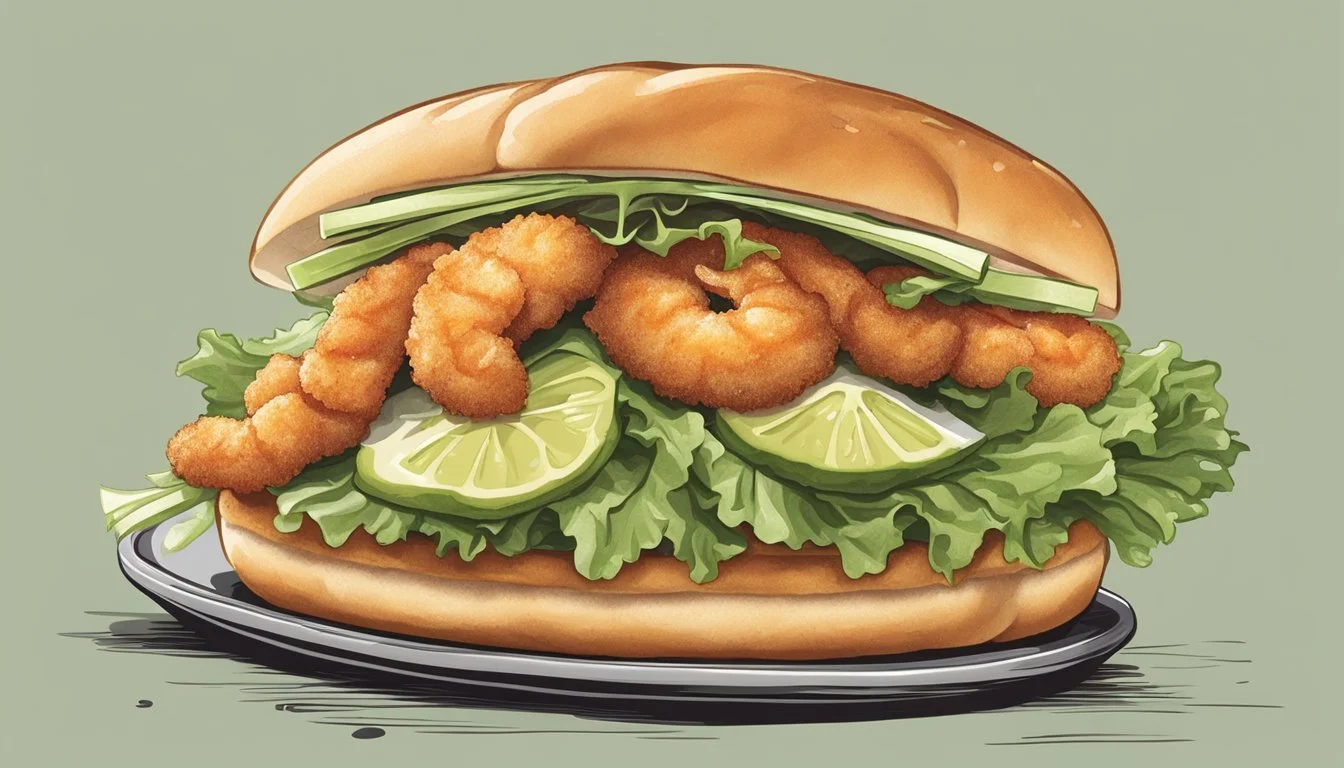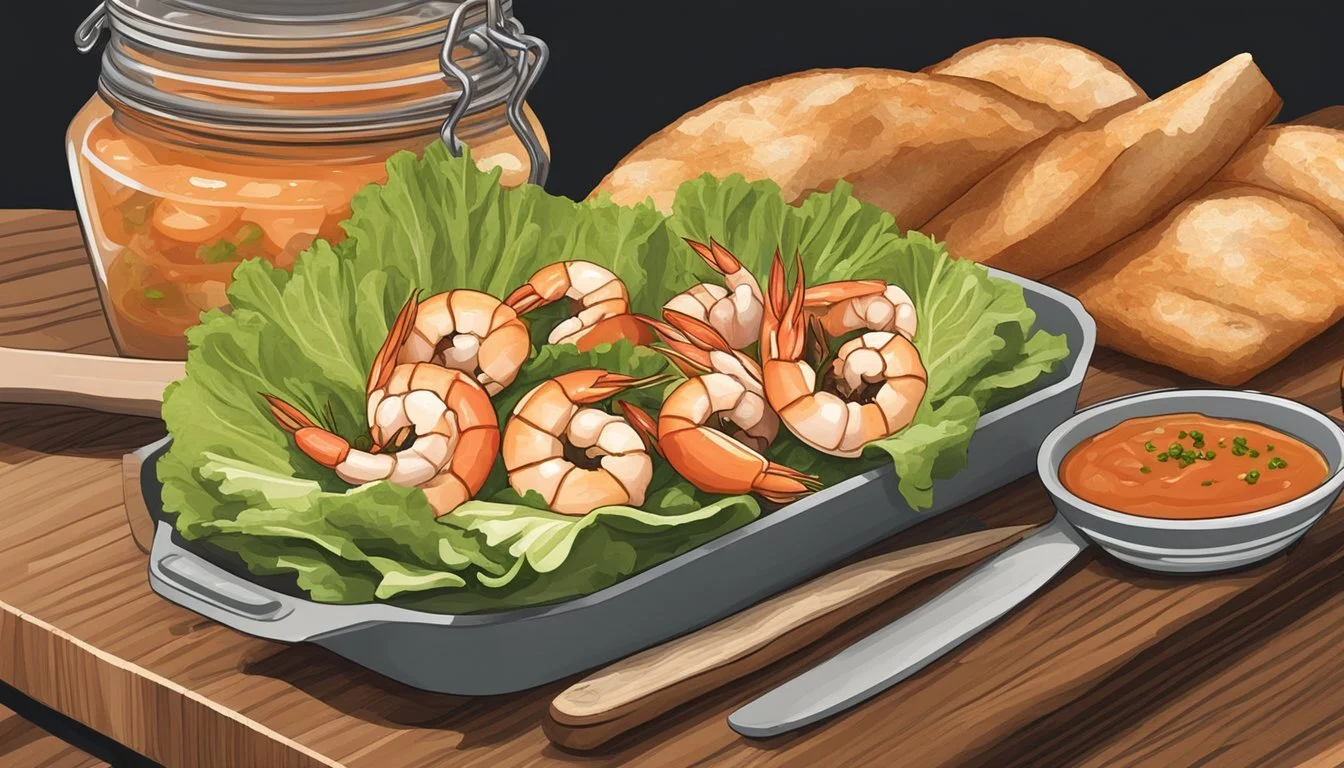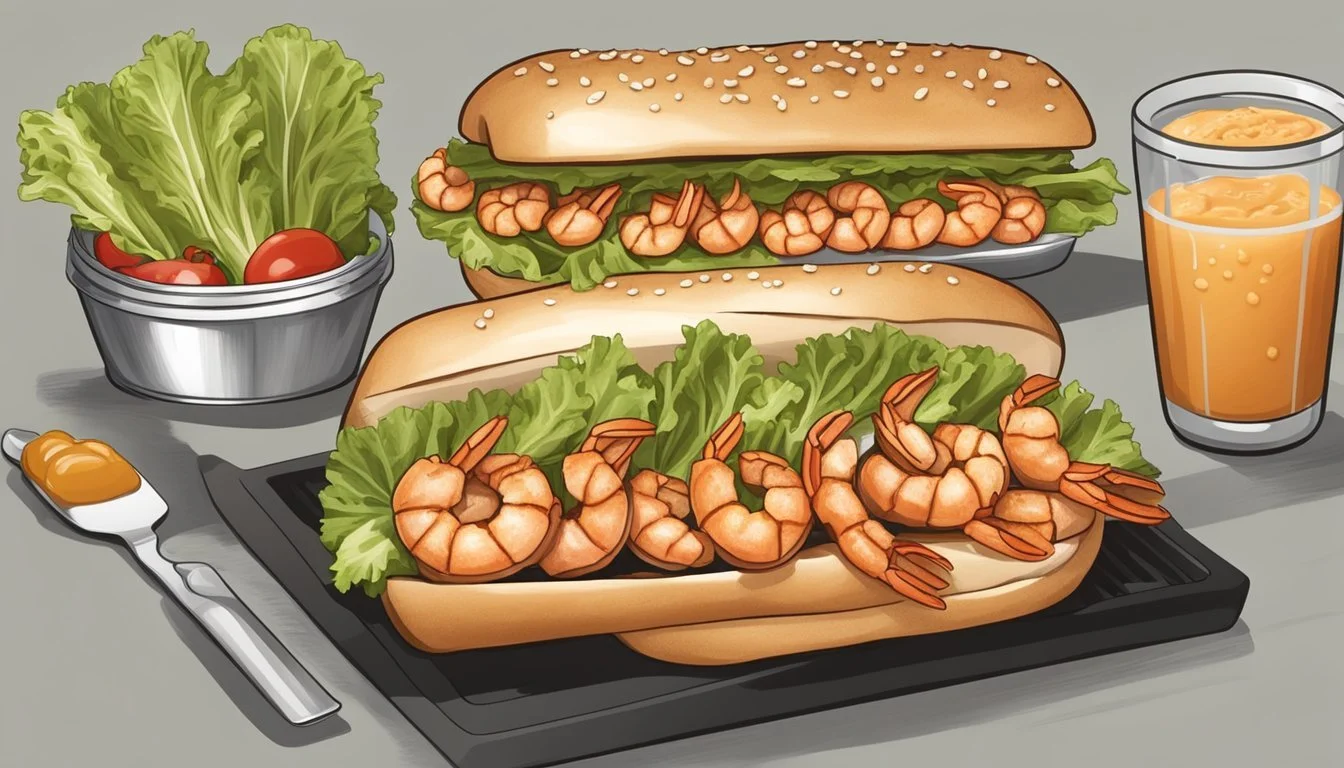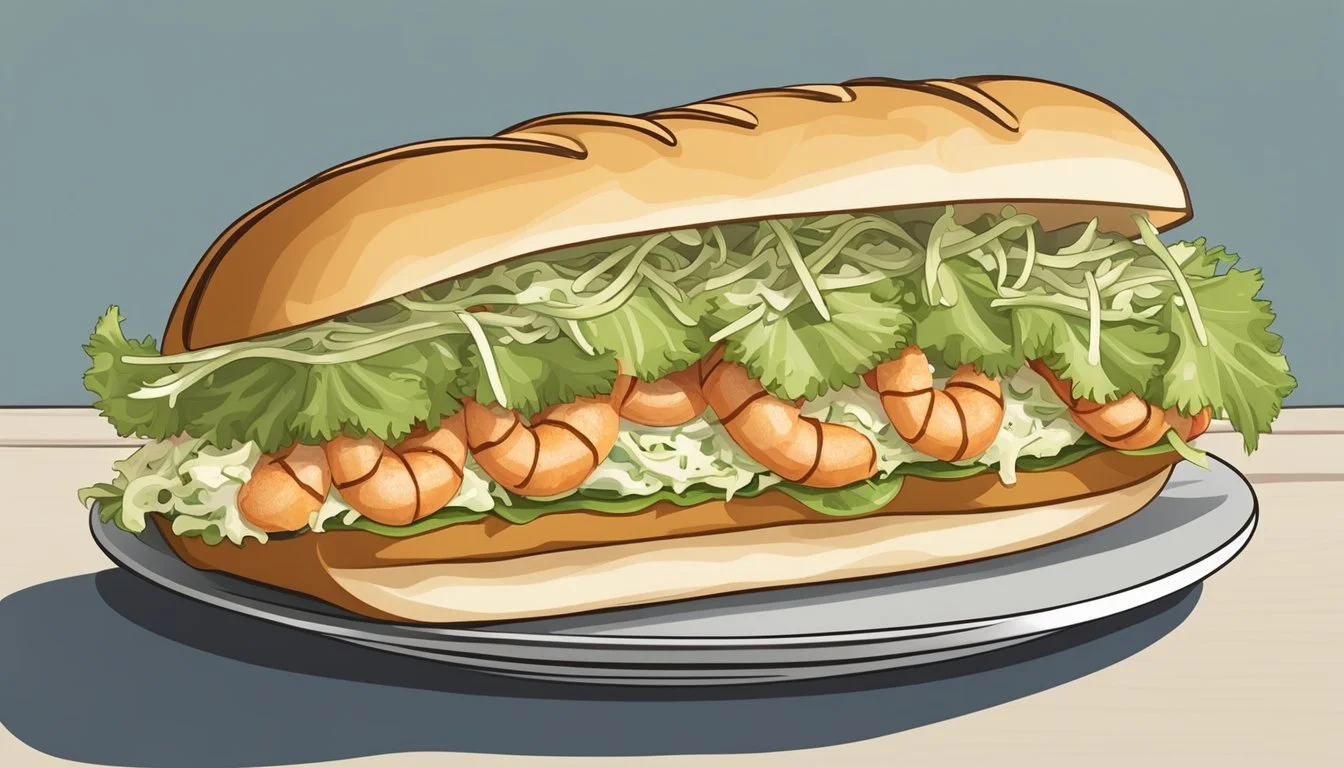How to Make a Texas-Style Shrimp Po' Boy
Your Ultimate Guide to This Southern Classic
A Texas-style shrimp (What wine goes well with shrimp?) po' boy is a lavish twist on the New Orleans classic, infusing the signature flavors of the Lone Star State into a hearty submarine sandwich. In true Texas fashion, it unapologetically embraces bold spices and generous portions, distinguishing itself through a distinct fusion of Southern charm and Southwestern zest. The sandwich begins with fresh, succulent shrimp, dusted with a vibrant blend of Cajun or Creole seasoning, then perfectly fried to achieve that sought-after crunch.
Building this iconic sandwich requires attention to detail, from the selection of a soft, yet crusty baguette, to the layering of crisp vegetables, and the smearing of a piquant sauce that ties all the flavors together. The sauce, a spirited remoulade or a spicier concoction, often includes mayonnaise, mustard, hot sauce, and a symphony of other ingredients such as horseradish and Worcestershire sauce, tailored to elevate the shrimp's flavor profile.
To assemble, the seasoned shrimp are nestled between the bread, which has been generously lathered with the tangy sauce, then topped with lettuce, tomatoes and sometimes pickles, delivering a satisfying crunch with every bite. A Texas-style shrimp po' boy isn't just a meal, it's an experience—a testament to the state's rich culinary diversity and the enduring appeal of this Southern staple.
History and Origin of the Po' Boy
Originating in Louisiana, the Po' Boy is a hallmark of New Orleans' rich culinary tradition. The sandwich's history is deeply intertwined with the city's culture, emphasizing casual dining with a flair for vibrant flavors.
It is said that the Po' Boy was born during a streetcar strike in 1929 when two former streetcar conductors, Bennie and Clovis Martin, served free sandwiches (What wine goes well with sandwiches?) to the strikers out of their French Quarter restaurant. These sandwiches were dubbed "poor boys," eventually shortened to Po' Boy, in sympathy with the "poor boys" on strike.
Traditionally, a Po' Boy sandwich consists of meat, often roast beef, or fried seafood such as shrimp, oysters (What wine goes well with oysters?), or fish. The protein is nestled in a crusty, fluffy New Orleans French bread, distinguished by its crisp crust and soft interior.
Ingredients Typical Inclusions Bread New Orleans French bread Protein Shrimp, oysters, or fish Toppings Lettuce, tomato, pickles Condiments Mayonnaise
The sandwich caters to a wide array of tastes, pairing well with a cold beer and epitomizing the laid-back, yet flavorful experience of New Orleans dining. While the Po' Boy has evolved with various interpretations, its essence remains a tribute to the blue-collar roots and the simplicity of a hearty meal that could carry one through a hard day's work.
The story behind the shrimp Po' Boy, a variety of the classic sandwich, highlights the use of local, fresh shrimp, lovingly dressed with mayonnaise, lettuce, pickle, and tomato, and served on the essential French bread, capturing the spirit of New Orleans in each bite.
Understanding Texas-Style Cuisine
Texas-Style Cuisine is characterized by bold flavors and a fusion of cultural influences, often encompassing hearty meats like brisket. It plays a pivotal role in the uniqueness of local dishes, including the Texas-style Po' Boy.
Texan Ingredients and Flavors
Texas boasts a rich culinary heritage that sees the extensive use of beef, especially brisket, a staple in Texas barbecue. Seasonings like cumin, chili powder, garlic, and smoked paprika often combine to create the distinctive Texan flavors. These ingredients form the backbone of many dishes in the region, imparting a robust and spicy profile that's immediately recognizable.
In the context of a Texas-style Po' Boy, expect to encounter:
Bold spices: Incorporating a generous seasoning with a mix of both succulent and spicy flavors.
Quality beef: Often replacing the traditional seafood found in Po' Boys with slow-cooked and tender Texas barbecue (What wine goes well with barbecue?) brisket.
Influence of Texan BBQ on Po' Boy
Texan barbecue, particularly smoked brisket, exerts significant influence on the local variety of Po' Boy sandwiches. The low-and-slow cooking approach central to Texas barbecue imparts a depth of flavor and tenderness to the meat:
Cooking Method Description Smoking Meat is often smoked over oak or hickory, which imbues it with a unique woodsy taste and an aromatic edge. Brisket Preparation Brisket in Texas is typically seasoned with a simple yet effective spice rub, creating a crust or 'bark' that's prized by diners.
This approach to brisket treatment transitions seamlessly into the Po' Boy, where the smoky, savory slices of beef contrast with and complement the typical fresh, crisp ingredients of the sandwich.
Key Ingredients for A Shrimp Po' Boy
Crafting the perfect Texas-Style Shrimp Po' Boy hinges on selecting quality ingredients. Each component, from the shrimp to the bread, plays a vital role in creating this classic sandwich.
Selecting the Best Shrimp
For a truly flavorful Po' Boy, one must choose fresh or frozen shrimp that are uniform in size to ensure even cooking. Large shrimp provide a satisfying bite and should be peeled, deveined, and tails removed. Seasoning the shrimp with spices such as garlic powder, pepper, and kosher salt enhances their natural flavor, crucial for the overall taste of the sandwich.
Bread Choices
The bread is the foundation of any Po' Boy. Hoagie rolls are the traditional choice; they should be fresh with a crisp crust and a soft interior. To add a Texas twist, one might lightly brush the cut sides of the roll with olive oil and toast it to add another layer of flavor and texture.
Additional Toppings and Variations
A Texas-Style Shrimp Po' Boy includes a spread of remoulade sauce—a creamy, tangy condiment that can be seasoned with Cajun or Creole spices. Fresh lettuce and slices of ripe tomato provide a crisp contrast to the warm, seasoned shrimp. For added crunch and tang, the sandwich can be topped with pickles. Some variations might include a slap of melted butter over the shrimp for richness. Each ingredient should be applied with consideration to balance flavors and textures, ensuring every bite is a testament to the Po' Boy tradition.
Preparing and Grilling the Shrimp
To begin, one should select fresh shrimp for optimal flavor and texture, aiming for medium to large size to stand out in the po' boy. The shrimp need to be peeled and deveined, which prepares them for even cooking and seasoning absorption.
Next, a marinade is essential for infusing the shrimp with a robust Texas-style taste. Combine olive oil, garlic (minced), lemon juice, and a mixture of seasonings such as salt, pepper, and oregano. The amount of garlic can be adjusted according to personal preference, but generally, two cloves provide a good balance.
Marinate the shrimp by placing them in the seasoned olive oil mixture. They should be thoroughly coated and then covered to marinate in the refrigerator. A marinating time of 30 minutes is sufficient for the flavors to meld, while longer can intensify the taste.
Once marinated, thread the shrimp onto skewers which have been soaked to prevent burning. Preheat the grill to medium-high heat, a setting that offers the intensity needed for a nicely charred exterior while keeping the inside juicy. Grill the shrimp for about 2-3 minutes on each side or until they turn a pinkish color and are slightly charred.
As grilled shrimp are the star of a po' boy, ensuring they're cooked just right is crucial. Overcooked shrimp can become rubbery, so one must stay vigilant, turning them promptly and removing them from the grill as soon as they're ready.
Assembling the Texas-Style Shrimp Po' Boy
The Texas-Style Shrimp Po' Boy is characterized by its crunchy fried shrimp and a blend of tangy, spicy condiments. The key to a successful assembly is layering the ingredients correctly for a balance of flavors and textures.
Layering Ingredients
To start building the Shrimp Po' Boy, one needs a soft, fresh hoagie roll or baguette. With the bread sliced almost all the way through, the base layer should consist of a handful of shredded lettuce, which offers a crisp, refreshing contrast. Next, a generous portion of cornmeal-crusted fried shrimp is arranged over the lettuce. These shrimp should be juicy on the inside with a satisfying crunch from the cornmeal coating.
Sauces and Condiments
After layering the main ingredients, the Texas-Style element shines through with the addition of bold condiments. A spicy remoulade sauce, rich in flavor, is slathered on the upper half of the bread. To enhance the sandwich further, slices of ripe tomato are added atop the shrimp. The sauce and tomatoes contribute juiciness and acidity, complementing the crunchy texture of the shrimp.
Nutritional Information
A Texas-style Shrimp Po' Boy can vary in its nutritional content based on the recipe and portion size. However, a standard serving typically includes the following key nutritional metrics:
Calories: An average shrimp po' boy sandwich may contain approximately 600-800 calories. The calorie count can increase with the addition of sauces or extra toppings.
Fat: This sandwich may have about 35-50 grams of fat, considering the use of oil for frying and the potential inclusion of mayonnaise-based sauces.
Saturated Fat: Saturated fat content is largely influenced by the type of oil used for frying and the mayonnaise in the sauce, contributing to roughly 5-10 grams per serving.
Cholesterol: Due to shrimp being the primary protein source, the cholesterol count might be higher, ranging from 150-200 milligrams.
Sodium: Prepared seasoning blends, sauces, and the brining of shrimp can contribute to a sodium level of about 1,500-2,000 milligrams.
Carbohydrates: Bread and batter contribute to the carbohydrate content, resulting in approximately 50-70 grams per sandwich.
Fiber: The fiber content will be relatively low unless served with whole-grain bread; otherwise, it may offer 2-3 grams of fiber.
Protein: Shrimp is an excellent source of protein, with a serving possibly containing 25-35 grams.
The nutritional values provided are estimates, and the actual numbers can vary based on recipe modifications and serving sizes. For a more accurate assessment, one should refer to specific recipes and calculate based on the exact ingredients used.
Serving and Enjoying Your Po' Boy
A Texas-style Shrimp Po' Boy brings a Lone Star twist to the classic sandwich. Perfectly seasoned, these sandwiches capture the essence of San Antonio's culinary flair and are best enjoyed with thoughtful pairings and attention to the dining experience.
Side Dishes and Pairings
Pairing a Texas-style Shrimp Po' Boy with the right side dishes enhances the meal. Traditional options with a Texas twist could include:
Coleslaw: A tangy coleslaw with a hint of jalapeño complements the spices of the Shrimp Po' Boy.
Sweet Potato Fries: Their natural sweetness provides a balance to the sandwich's heat.
Spicy Corn on the Cob: Grilled and dusted with chili powder, this side reinforces the Texas theme.
Iced Tea: Sweet or unsweetened, it's a Southern dining staple that refreshes the palate.
Tips for a Perfect Meal Experience
Here are some recommendations for a flawless Po' Boy experience:
Toasting the Bun: Toasting the bun adds texture and prevents sogginess from the remoulade sauce.
Sauce on the Side: Serve the remoulade on the side to allow diners to adjust to their preference.
Fresh Ingredients: Shrimp should be fresh or properly thawed, and vegetables crisp to ensure the best flavors and textures.
Portion Control: Ensure a generous but manageable amount of shrimp in each sandwich to avoid it being overly messy.
Alternative Versions of the Po' Boy
While the classic Texas-style Shrimp Po' Boy is a beloved staple, there are several other variations of this sandwich that cater to different tastes and dietary preferences. The use of various meats and non-meat substitutes allows for a broad spectrum of flavors and textures.
Meat Variations in Po' Boy
Beef: Slices of tender roast beef, often simmered in gravy, make for a hearty Po' Boy. They are sometimes topped with fried onions and green peppers to add a sweet and slightly bitter taste.
Kielbasa: This Polish sausage, grilled and sliced, gives the sandwich a smoky flavor. Combined with sautéed onions and peppers, it provides a savory alternative.
Pulled Pork: Tender pulled pork, smothered in barbecue sauce, offers a tangy and succulent option. It's commonly paired with coleslaw for crunch and contrasting flavor.
Salmon: A lighter option, grilled salmon (What wine goes well with grilled salmon?) fillets seasoned with Cajun spices add an omega-3 rich variety. They're often complemented by a remoulade sauce that echoes the zesty flavors found in the classic shrimp version.
Grilled Chicken: Juicy, marinated chicken breasts give a leaner protein choice. It's commonly dressed with lettuce and tomato for freshness.
Vegetarian and Vegan Alternatives
Fried Green Tomatoes: A Southern classic, fried green tomatoes provide a tangy and crisp vegetarian center for a Po' Boy.
Mushroom and Corn: Portobello mushrooms, grilled and seasoned, coupled with sweet corn, offer a satisfying umami flavor that's heightened when topped with a spicy vegan remoulade.
Jackfruit: A popular vegan substitute, jackfruit can be seasoned and cooked to mimic the texture of pulled pork, providing a plant-based version of the pulled pork sandwich.
Bell Peppers and Onions: For a simple vegan option, sautéed bell peppers and onions seasoned with Creole spices can be a flavorful filling for the Po' Boy.









